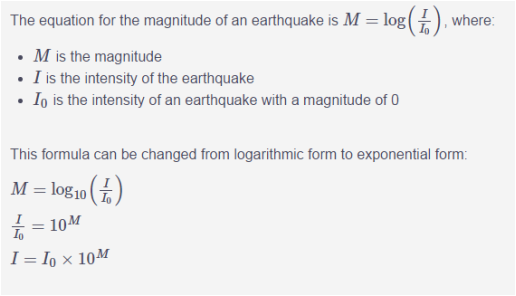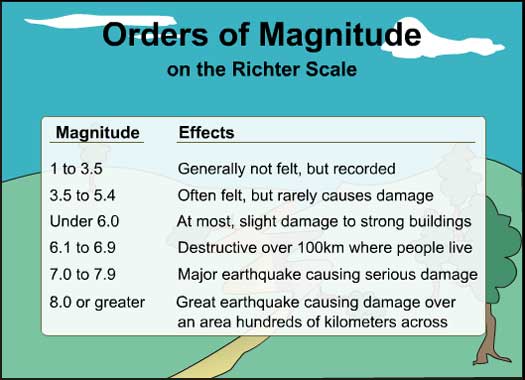Earthquake Magnitude Scale Explained

Earthquake Magnitude Scale Explained. We are also able to explain the difference between the earthquake magnitude and intensity. Seismic magnitude scales are used to describe the overall strength or size of an earthquake. It's based around the seismic moment and the moment this site might help you. Seismic moment combines the seismic energy with offset on the fault and rigidity of rock. How is earthquake magnitude measured? The richter scale measures the magnitude of an earthquake (how powerful it is). Earthquake magnitude (earthquake intensity) the magnitude of an earthquake can be estimated from its destructiveness using the mercalli scale. It is measured using a machine called a seismometer which produces a seismograph. It was invented in 1935 by charles f. Earthquake magnitude classes are shown in the table below.
We can feel the earthquake, and objects inside are going to shake around, but there very rarely is here is the full scale: The magnitude scale is logarithmic. Moment magnitude is more effective for large earthquakes moment magnitude uses more variables to calculate the energy released using seismic moment. Earthquakes, until recently, have been measured on the richter scale. Richter set up a magnitude scale of earthquakes as the logarithm to base 10 of the maximum seismic wave amplitude (in. The moment magnitude scale is the preferred scale because it covers a wider range of magnitudes and can be applied globally. Like many other scales in science (decibel is another example), richter scale is not linear. The earthquake magnitude scale goes up exponentially, which can be a challenging concept. The richter scale measures the magnitude of an earthquake (how powerful it is). Earthquakes are very hard to measure on a standard scale of size.

Like many other scales in science (decibel is another example), richter scale is not linear.
Moment magnitude is more effective for large earthquakes moment magnitude uses more variables to calculate the energy released using seismic moment. Earthquake magnitude is a measure of the size, or amplitude, of the in 1935 the american seismologist charles f. The moment magnitude scale (i'll call it mms) is used to compare the amount of energy released by earthquakes. Sensitive probes called seismographs detect shaking in the ground, which could be generated by a quake nearby or one on. Earthquakes are very hard to measure on a standard scale of size. Richter of the california institute of technology as a mathematical device to compare the size of earthquakes. The time, location, and magnitude of an earthquake can be determined from the data recorded by seismometer. Almost all california earthquakes are shallow, so the scale got by without taking into account the depth of an earthquake. It was invented in 1935 by charles f. Trump's election legal blitz, explained. Each seismometer records the shaking of the ground directly beneath it. The seismic strength of every earthquake gets calculated based on a now universal magnitude scale. These are distinguished from seismic intensity scales that categorize the intensity or severity of ground shaking (quaking) caused by an earthquake at a given location. The magnitude scale is logarithmic.
The measurement explains the severity of earthquake shaking and its effects on people and their environment. Usgs explains for earthquakes that occurred between about 1890 (when modern. Here's where that scale came from and how it works. Describe the moment magnitude scale and explain why it is useful in masuring earthquakes.?

Only relatively local quakes were on the list, so the scale didn't need to deal with distant quakes.
Noodles can be used to teach relative magnitude. Ailsa allaby and michael allaby earthquake magnitude. a dictionary of earth sciences. The seismic strength of every earthquake gets calculated based on a now universal magnitude scale. Moment magnitude is more effective for large earthquakes moment magnitude uses more variables to calculate the energy released using seismic moment. It is measured using a machine called a seismometer which produces a seismograph. The magnitude of earthquake is determined from measurements on seismographs, whereas the intensity is determined from effects on people normal numbers are used to determine the magnitude of earthquake. Earthquakes that fall between 3.0 to 3.9 on the scale are considered minor. 15, 2011 , 5:15 pm. Here's where that scale came from and how it works. We are also able to explain the difference between the earthquake magnitude and intensity. The problem is like finding one number for the today seismic events may be measured based on body waves or surface waves (these are explained in earthquakes in a nutshell). The time, location, and magnitude of an earthquake can be determined from the data recorded by seismometer. While the richter scale is widely known and the mmi scale is used in the united states, there are other magnitude and intensity scales in use around the. Mms measures the movement of rock along the fault. The assessment of earthquake intensity on a descriptive scale depends on actual observations of earthquake effects.
The seismic strength of every earthquake gets calculated based on a now universal magnitude scale. Noodles can be used to teach relative magnitude. Scientists use different scales to indicate the intensity and magnitude of an earthquake including the mercalli, richter and moment magnitude. Richter's original scale of earthquake magnitudes had a number of limitations. Richter of the california institute of technology as a mathematical device to compare the size of earthquakes. It is measured using a machine called a seismometer which produces a seismograph.

Each seismometer records the shaking of the ground directly beneath it.
Describe the moment magnitude scale and explain why it is useful in masuring earthquakes.? The magnitude scale is logarithmic. The time, location, and magnitude of an earthquake can be determined from the data recorded by seismometer. The problem is like finding one number for the today seismic events may be measured based on body waves or surface waves (these are explained in earthquakes in a nutshell). Each seismometer records the shaking of the ground directly beneath it. Seismometers record the vibrations from earthquakes that travel through the earth. The magnitude of earthquake is determined from measurements on seismographs, whereas the intensity is determined from effects on people normal numbers are used to determine the magnitude of earthquake. While the richter scale is widely known and the mmi scale is used in the united states, there are other magnitude and intensity scales in use around the. The richter scale measures the magnitude of an earthquake (how powerful it is). Today, earthquake magnitude measurement is based on the moment magnitude scale (mms). The moment magnitude scale is the preferred scale because it covers a wider range of magnitudes and can be applied globally. Braile's collection of earthquake hazard information, that explains it quite nicely The seismic strength of every earthquake gets calculated based on a now universal magnitude scale. Each point higher represents an order of magnitude higher — e.g but, prior to seismographs, magnitudes have to be estimated.
The problem is like finding one number for the today seismic events may be measured based on body waves or surface waves (these are explained in earthquakes in a nutshell) earthquake scale explained. Sensitive probes called seismographs detect shaking in the ground, which could be generated by a quake nearby or one on.
 Source: i.cbc.ca
Source: i.cbc.ca Earthquake magnitude (earthquake intensity) the magnitude of an earthquake can be estimated from its destructiveness using the mercalli scale.
 Source: i.pinimg.com
Source: i.pinimg.com Seismic magnitude scales are used to describe the overall strength or size of an earthquake.
 Source: pixfeeds.com
Source: pixfeeds.com Earthquake magnitude classes are shown in the table below.
 Source: ahscougarcall.com
Source: ahscougarcall.com Only relatively local quakes were on the list, so the scale didn't need to deal with distant quakes.
 Source: www.amansmathsblogs.com
Source: www.amansmathsblogs.com Describe how earthquakes are predicted a single sharp jolt measures higher on the richter scale than a very long intense earthquake.
 Source: s.abcnews.com
Source: s.abcnews.com Moment magnitude is more effective for large earthquakes moment magnitude uses more variables to calculate the energy released using seismic moment.
 Source: www.differencebetween.info
Source: www.differencebetween.info Like many other scales in science (decibel is another example), richter scale is not linear.
 Source: s.abcnews.com
Source: s.abcnews.com Scientists use different scales to indicate the intensity and magnitude of an earthquake including the mercalli, richter and moment magnitude.
Sensitive probes called seismographs detect shaking in the ground, which could be generated by a quake nearby or one on.
 Source: 3.bp.blogspot.com
Source: 3.bp.blogspot.com The time, location, and magnitude of an earthquake can be determined from the data recorded by seismometer.
 Source: i.cbc.ca
Source: i.cbc.ca Earthquake magnitude classes are shown in the table below.
 Source: i.pinimg.com
Source: i.pinimg.com Earthquakes that fall between 3.0 to 3.9 on the scale are considered minor.
 Source: st3.depositphotos.com
Source: st3.depositphotos.com The moment magnitude scale (i'll call it mms) is used to compare the amount of energy released by earthquakes.
 Source: www.allaboutanthem.com
Source: www.allaboutanthem.com Earthquake magnitude classes are shown in the table below.
 Source: us-static.z-dn.net
Source: us-static.z-dn.net Describe the different earthquake magnitude scales and what the numbers for moment magnitude mean.
 Source: www.sfu.ca
Source: www.sfu.ca Earthquakes, until recently, have been measured on the richter scale.
 Source: img.dailythanthi.com
Source: img.dailythanthi.com It is measured using a machine called a seismometer which produces a seismograph.
 Source: image.slidesharecdn.com
Source: image.slidesharecdn.com Sensitive probes called seismographs detect shaking in the ground, which could be generated by a quake nearby or one on.
 Source: i.pinimg.com
Source: i.pinimg.com Earthquake magnitude classes are shown in the table below.
 Source: exponential-logarithm-project.weebly.com
Source: exponential-logarithm-project.weebly.com The time, location, and magnitude of an earthquake can be determined from the data recorded by seismometer.
 Source: catevew6.weebly.com
Source: catevew6.weebly.com Only relatively local quakes were on the list, so the scale didn't need to deal with distant quakes.
 Source: www.iris.edu
Source: www.iris.edu Earthquake magnitude is a measure of the size, or amplitude, of the in 1935 the american seismologist charles f.
 Source: www.charlesapple.com
Source: www.charlesapple.com The assessment of earthquake intensity on a descriptive scale depends on actual observations of earthquake effects.
 Source: image.slidesharecdn.com
Source: image.slidesharecdn.com Earthquake magnitude is a measure of the size, or amplitude, of the in 1935 the american seismologist charles f.
 Source: i.pinimg.com
Source: i.pinimg.com The moment magnitude scale is the preferred scale because it covers a wider range of magnitudes and can be applied globally.
Posting Komentar untuk "Earthquake Magnitude Scale Explained"